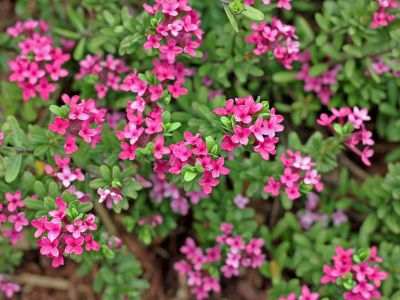Growing Daphne Plants
Before you decide that this fragrant beauty is just what you want, there are a couple of things you should know about daphne. First of all, the plant is poisonous. In fact, it is so toxic that chewing on the flowers, foliage, or red berries can be fatal. You should never plant daphne shrubs where pets or children play. Another potential problem with daphne is that it is known to die suddenly and seemingly without cause. Due to this tendency, you should think of it as a temporary plant. Place the shrub in areas where you can easily remove and replace it as it becomes necessary. If you can live with these two drawbacks, you’ll find that caring for daphne plants is not difficult. Grown as an informal shrub, it doesn’t need pruning, and this makes the plant practically carefree. For a more formal appearance, trim the tips of the stems after the flowers fade.
Daphne Plant Varieties
One challenge of growing daphne plants is choosing a type. There are several varieties of daphne, and these are the most commonly grown and easily available:
Winter daphne (D. odora) is the variety to choose if you like a powerful fragrance. 4 feet (1 m.) tall with narrow, glossy leaves, winter daphne is the type most likely to suffer from sudden death syndrome. The flowers bloom in late winter. ‘Aureo-Marginata’ is a popular winter daphne with variegated leaves. Garland daphne (D. cneorum) is a low grower that reaches heights of less than a foot (31 cm.), making it ideal for rock gardens and edging pathways. The trailing branches spread about 3 feet (91 cm.). Covered with flowers in the spring, you can cover the stems with mulch after the flowers fade to encourage rooting. The best varieties include ‘Eximia,’ ‘Pgymaea Alba,’ and ‘Variegata.’ D. x burkwoodii can be evergreen, semi-evergreen, or deciduous, depending on the climate zone. It grows 3 to 4 feet (1 m.) tall and blooms in late spring, often followed by a second flush of flowers in late summer. The popular ‘Carol Mackie’ is a variegated variety.
How to Care for Daphne
Daphne grows in U.S. Department of Agriculture plant hardiness zones 4 or 5 to 9 but check the type you want to grow since there is a lot of variation from plant to plant. It needs a location with full sun or partial shade and moist soil. Well-drained soil is a must. Choose your site well because daphne doesn’t like to be transplanted. Plants grow best if they are given a thick but light layer of mulch. This helps keep the roots cool and the soil moist. Even though the soil is covered, check to make sure it never dries out. It’s best to water the shrub when rainfall is scarce.
